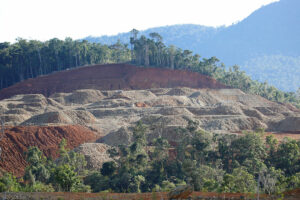




Philippines Trade Update: Trade trajectories trend along
 DOWNLOAD
DOWNLOAD

Policy Rate Updates: Double cut finale
 DOWNLOAD
DOWNLOAD

Monthly Economic Update: One for the road
 DOWNLOAD
DOWNLOAD


DoF lowers revenue projections from mining fiscal reform bill to PHP 6.3 billion

The Department of Finance (DoF) has lowered its yearly revenue estimates to PHP 6.3 billion from PHP 10.23 billion in the next four years from a proposed five-tier margin-based tax system for the mining industry amid lower metal prices.
The government is expected to earn PHP 4.48 billion from royalty tax on miners inside mineral reservations, PHP 1.07 billion from those outside reservations, and PHP 730 million from windfall profit tax, Finance Assistant Secretary Karlo Adriano S. Fermin told a Senate hearing on Monday.
The DoF is now proposing to impose a 1.5-5% margin-based royalty rate with five tiers for miners outside mineral reservations, as well as a 1-10% windfall profit tax with five tiers.
It still wants to keep the regime where large-scale metallic mining operations inside mineral reservations pay the government 5% of their gross output.
Under its previous four-tier proposal, the DoF had expected to generate PHP 5.5 billion from royalties from miners operating within mineral reservations, PHP 1.31 billion from royalties on miners outside reservations, and PHP 3.37 billion from windfall profit tax.
Mr. Fermin said the revenue projections were revised to reflect the latest data and lower prices in the world market.
“Number one, this comes from new data and number two, metallic prices have gone down,” he told BusinessWorld on the sidelines of the hearing.
Based on Aug. 15 data from the Mines and Geosciences Bureau, nickel prices dropped by 19.1% to USD 16,035 per metric ton (/MT) from USD 19,825/MT a year earlier. Gold prices stood at USD 2,449 per ounce, up by 28.5% from $1,906 per ounce a year ago, while copper prices rose by 8.1% to USD 8,906/MT from USD 8,242/MT.
Mr. Fermin said the five-tier system was a compromise made after consultations with mining stakeholders, who expressed fears about a higher effective tax rate for the industry.
“Of course, with more tiers, you have more rates, right?” he told BusinessWorld in Filipino. “But with fewer tiers, there are fewer rates, but the advance might be larger.”
The DoF’s latest proposal differs from House Bill No. 8937, approved in September 2023, which proposed that large-scale miners in mineral reservations pay the government only 4% of their gross output. The House version also included a margin-based royalty rate of 1.5-5% with eight tiers, and a 1-10% windfall profit tax with 10 tiers.
“We think the net effect (of the five-tier system) will be the same (compared with the four-tier system),” Chamber of Mines of the Philippines Executive (CoMP) Director Ronald S. Recidoro told BusinessWorld after the hearing.
“It’s just a simpler implementation and as the assistant secretary (Mr. Fermin) said, it will disincentivize aggressive accounting since too many tiers would encourage this.”
Mr. Recidoro said the measure would ease the uncertainty surrounding the Philippine mining sector and encourage more foreign investors to come in.
“This (measure) will really provide a good environment for foreign investors, to show that there is stability in our tax regime,” Philex Mining Corp. Senior Vice-President and Chief Financial Officer Romeo B. Bachoco told the same hearing.
The existing tax system for mining companies requires them to pay corporate income tax, excise tax, royalty, local business tax, real property tax, and fees to indigenous communities.
The DoF’s proposal also includes a provision treating mining contractors as separate taxable entities under law “with respect to each and every mineral agreement it holds or operates,” Mr. Fermin said.
“The passage of a new tax law should not only boost our nation’s revenue coffers,” CoMP Chairman Michael T. Toledo said told the Senate panel.
“Among other policy challenges that need to be addressed, it is crucial to establish a stable and predictable mining tax regime.” – John Victor D. Ordoñez, Reporter
This article originally appeared on bworldonline.com





 By BusinessWorld
By BusinessWorld